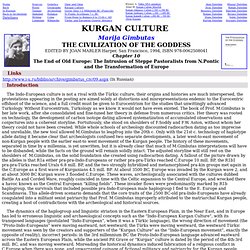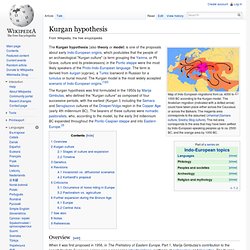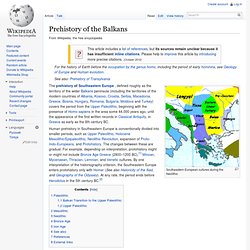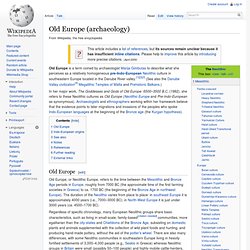

Thraxus Ares - UNGARIA, O TARA DE INCREDERE? Ungaria a avut în... TV » Adevarul despre condamnarea Iuliei Timosenko. La Marche, France. M.Gimbutas - Kurgan Culture - TurkicWorld. The collapse of Old Europe coincides with the process of Indo-Europeanization (i.e.

“Kurganization”) of Europe, a complicated transformative process leading to a drastic cultural change reminiscent of the conquest of the American continent. Archeological evidence, supported by comparative Indo-European linguistics and mythology, suggests a clash of two ideologies, social structures and economies perpetrated by trauma-inducing institutions. The Proto- or Early Indo-Europeans, whom I have labeled “Kurgan” people, arrived from the east, from southern Russia, on horseback. Their first contact with the borderland territories of Old Europe in the Lower Dnieper region and west of the Black Sea began around the middle of the 5th millennium BC A continuous flow of influences and people into east-central Europe was initiated which lasted for two millennia. FIGURE 10-1 Earliest sculptures associated with the horse and oxen cult (what cult? The last untouchable in Europe - Europe - World. Sitting in her little house near Tarbes, in the French Pyrenees, Marie-Pierre Manet-Beauzac is talking about her ancestry.

For most people this would be agreeable, perhaps even pleasurable. For the 40-something mother-of-three, the story of her bloodline is marked with a unique sadness: because she belongs to an extraordinary tribe of hidden pariahs, repressed in France for a thousand years. Marie-Pierre is a Cagot. If the word "Cagot" means nothing to you, that is not surprising. The history of the Cagot people is obscure; some assert it has been deliberately erased. Except, uniquely, for Marie-Pierre herself. "And that's when I noticed certain names and trades in my background, lots of humble carpenters, basket-makers, poor people, people who lived in the 'wrong' parts of town. Originea etnica a Ungurilor, Secuilor si Ceangailor [1/4] Demographics of Kosovo. Upload.wikimedia.org/wikipedia/commons/d/d3/IMPERIUL_ROMAN_IN_125.svg.
Romes Lost Empire (BBC) Kurgan hypothesis. Map of Indo European migrations from ca. 4000 to 1000 BC according to the Kurgan model.

The Anatolian migration (indicated with a dotted arrow) could have taken place either across the Caucasus or across the Balkans. The magenta area corresponds to the assumed Urheimat (Samara culture, Sredny Stog culture). The red area corresponds to the area that may have been settled by Indo-European-speaking peoples up to ca. 2500 BC, and the orange area by 1000 BC. The Kurgan hypothesis (also theory or model) is one of the proposals about early Indo-European origins, which postulates that the people of an archaeological "Kurgan culture" (a term grouping the Yamna, or Pit Grave, culture and its predecessors) in the Pontic steppe were the most likely speakers of the Proto-Indo-European language. The term is derived from kurgan (курган), a Turkic loanword in Russian for a tumulus or burial mound. Overview[edit] Historical spread of the chariot.
Kurgan culture[edit] Stages of culture and expansion[edit] Prehistory of the Balkans. For the history of Earth before the occupation by the genus homo, including the period of early hominins, see Geology of Europe and Human evolution.

Southeastern European cultures during the Neolithic The prehistory of Southeastern Europe , defined roughly as the territory of the wider Balkans peninsula (including the territories of the modern countries of Albania, Kosovo, Croatia, Serbia, Macedonia, Greece, Bosnia, Hungary, Romania, Bulgaria, Moldova and Turkey) covers the period from the Upper Paleolithic, beginning with the presence of Homo sapiens in the area some 44,000 years ago, until the appearance of the first written records in Classical Antiquity, in Greece as early as the 8th century BC.
Human prehistory in Southeastern Europe is conventionally divided into smaller periods, such as Upper Paleolithic, Holocene Mesolithic/Epipaleolithic, Neolithic Revolution, expansion of Proto-Indo-Europeans, and Protohistory. The changes between these are gradual. Paleolithic[edit] Old Europe (archaeology) Old Europe is a term coined by archaeologist Marija Gimbutas to describe what she perceives as a relatively homogeneous pre-Indo-European Neolithic culture in southeastern Europe located in the Danube River valley.[1][2][3] (See also the Danube Valley civilization[4] Megalithic Temples of Malta and Prehistoric Balkans.)

In her major work, The Goddesses and Gods of Old Europe: 6500–3500 B.C. (1982), she refers to these Neolithic cultures as Old Europe (Neolithic Europe and Pre-Indo-European as synonymous).